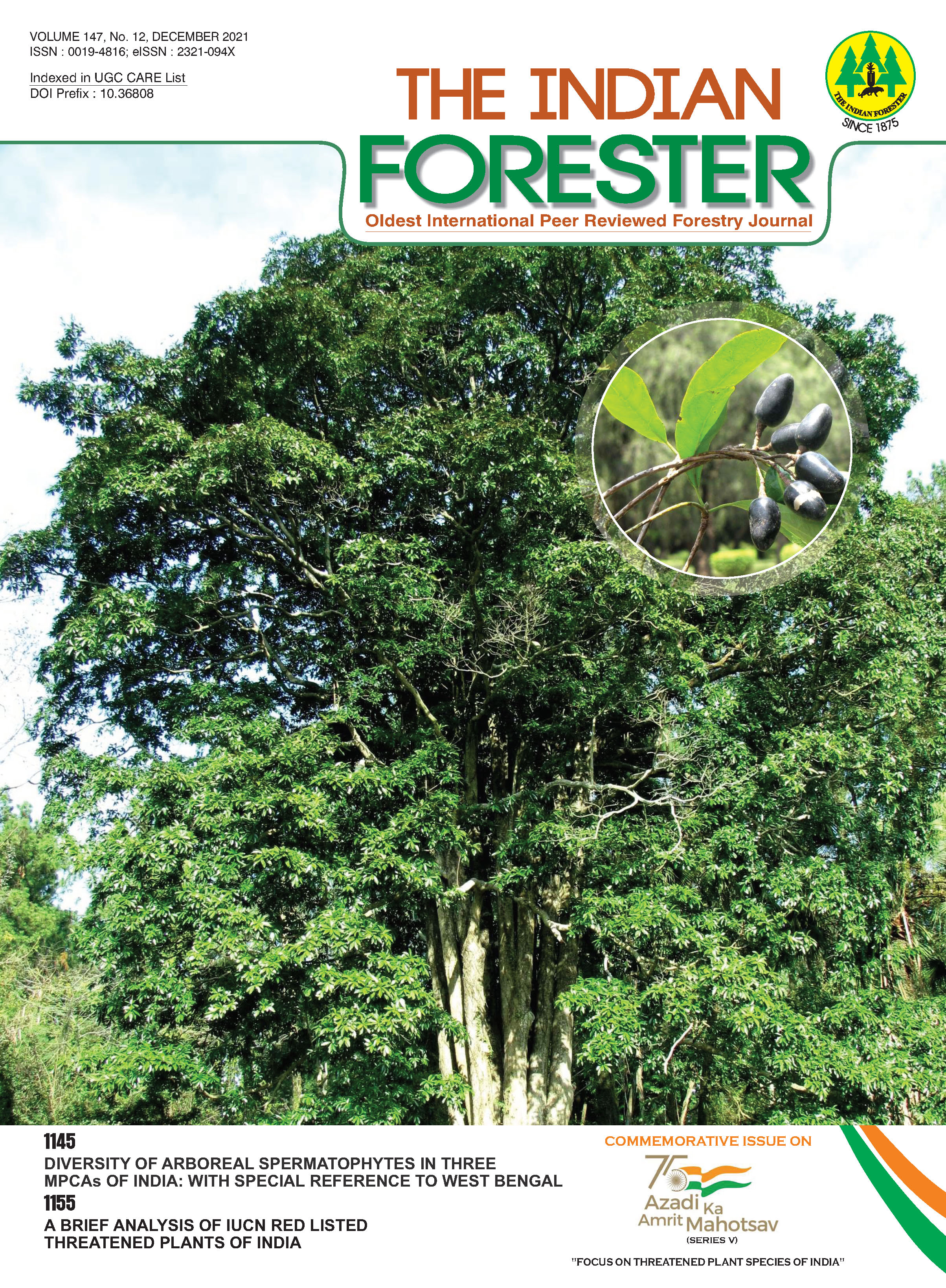Diversity of Arboreal Spermatophytes in three MPCAs of India: With Special Reference to West Bengal
DOI:
https://doi.org/10.36808/if/2021/v147i12/158451Keywords:
Arboreal Spermatophyte, Indices, IUCN, MPCAs, NTFPs.Abstract
Medicinal Plant Conservation Areas (MPCAs) are the patches in protected forests with rich indigenous medicinal plant species. Arboreal spermatophyte heterogeneity and floristic arrangement of three Medicinal Plant Conservation Area (MPCAs) of West Bengal were assessed with an aim to acquire a baseline data assumption for medicinally important trees and their proper in situ conservation strategies for the floristically affluent ecosystem. The study was made during the period of 2014-2020 by following standard sampling method and by random quadrates. It was observed that study areas are quite enriched with about 164 trees species representing 52 families and maximum species are found to be used to treat various ailments in Indian system of medicines. Various diversity indices were calculated to understand the community structure for the tree layer and it was found quite significant. These quantitative measures pointed the diversity of the arboreal spermatophytes of the study area in its structure, composition, function and vegetation dynamics. The present study also highlights various types of anthropogenic intervention, including NTFPs (Non Timber Forest Products) collection and artificial forest-fire causing dangerous threats for the maintenance of its original vegetation and survival of numerous threatened and endangered species in all the strata of the vegetation.References
Ansari A.A., Gill S.S., Abbas Z.K. and Naeem M. (2016). Biodiversity: Monitoring, Assessment and Conservation. CAB International Publications, UK 628 pp.
Bhat J.A., Kumar M., Negi A.K., Todaria N.P., Malik Z.A., Pala N.A., Kumar A. and Shukla G. (2020). Species diversity of woody vegetation along altitudinal gradient of the Western Himalayas, Global Ecology and Conservation, 24: e01302.
Chowdhury D. (2015). Distribution and chemotaxonomy of some members of Lauraceae in Terai and Duars region of West Bengal. Ph.D Thesis. Department of Botany. University of North Bengal, West Bengal, India: 261pp.
Das A.P., Ghosh C., Sarkar A., Biswas R., Biswas K., Chowdhury D., Lama A., Moktan S. and Chowdhury A. (2010). Preliminary report on the Medicinal Plants from three MPCAs in Terai and Duars of West Bengal, India, Pleione, 4(l): 90–101.
Dash P.K., Mohapatra P.P. and Rao Y.G. (2009). Diversity and distribution of tree species in Niyamgiri hill ranges, Orissa, India, Indian Forestry, 135: 927–942.
Grierson A.J.C. and Long D.G. (1983, 1994, 1987). Flora of Bhutan. Vol. 1, Parts 1, 2 & 3. Royal Botanical Garden, Edinburgh.
Grierson A.J.C. and Long D.G. (1991, 1999, 2001). Flora of Bhutan, Vol. 2, Parts 1, 2 & 3. Royal Botanical Garden, Edinburgh.
Hara H. (1966). Flora of Eastern Himalaya. Tokyo University, Tokyo 744pp.
Hara H., Chater A.Q. and Williams L.H.J. (1982). An Enumeration of the Flowering Plants of Nepal. Vol. III. British Museum of Natural History, London, 226pp.
Hara H., Stearn W.T. and Williams L.H.J. (1978). An Enumeration of the Flowering Plants of Nepal. Vol. 1. British Museum of Natural History, London.
Hara H. and Williams L.H.J. (1979). An Enumeration of the Flowering Plants of Nepal. Vol. II. British Museum of Natural History, London, 154pp.
Hooker J.D. (1872 - 1897). The Flora of British India, Vols 1-7. L. Reeve & Co. Ltd., Ashford, Kent, London.
Jain S.K. and Rao R.R. (1977). A Handbook of Field and Herbarium Methods. Today & Tomorrow's Printers and Publishers, New Delhi, India, 157pp.
Margalef R. (1968). Information theory of ecology, Journal of General Systems,3: 36–71.
Menhinick E.F. (1964). A comparison of some species diversity indices applied to samples of field insects, Ecology, 45: 858–861.
Misra R. (1966). Ecology Workbook. Oxford & I. B. H. Calcutta, India, 244pp.
Nayar M.P. and Sastry A.R.K. (1987). Red Data Book of Indian Plants, Vol. 1. Botanical Survey of India, Calcutta, India.
Nayar M.P. and Sastry A.R.K. (1990). Red Data Book of Indian Plants, Vol. 3. Botanical Survey of India, Calcutta, India.
Noltie H.J. (1994; 2000). Flora of Bhutan Vol. 3 Parts 1 & 2. Royal Botanical Garden, Edinburgh.
Odum E.P. (1971). Fundamentals of Ecology. WB Saunders Co., Philadelphia, pp. 574.
Ohashi H. (1975). The Flora of Eastern Himalaya, 3rd Report, Tokyo University, Tokyo.
Olson D.M. and Dinerstein E. (2002). The Global 200: Priority Eco regions for Global Conservation,Annals of the Missouri Botanical Garden,89:199–224.
Olson D.M., Dinerstein E., Wikramanayake E.D., Burgess N.D., Powell G.V.N., Underwood E. C., D'amico J. A., Illanga I., Strand H.E., Morrison J.C., Loucks C.J., Allnutt T.F., Ricketts T.H., Kura Y., Lamoreux J.F., Wettengel W.W., Hedao P. and Kassem K.R. (2001). Terrestrial Ecoregions of the World: A New Map of Life on Earth, Bio Science, 51: 933–938.
Paul P., Dhar S., Das D. and Chowdhury M. (2020). Herberium Technique. Orange Book Publication, Chhattisgarh, India.
Pielou E.C. (1966). The Measurement of Diversity in Different Types of Biological Collections. Journal of Theoretical Biology, 13: 131-144. http://dx.doi.org/10.1016/0022-5193(66)90013-0 Prain D. (1903). Bengal Plants. Vol. I & II. West, Newman & Co., London.
Pramanik B.K. and Das D. (2015). Preliminary Phytosociological Study of Medicinal Plants Conservation Area (MPCA) At Forests of Buxa Tiger Reserve (BTR) and Gorumara National Park,Journal of Environmental Science, Toxicology and Food Technology, 9: 64–77.
Rai U. (2006). Plant Biodiversity Characterization in Darjiling Hills using Remote Sensing technique. Ph.D. Thesis, University of North Bengal, West Bengal, India: pp. 341.
Shannon C.E. and Weiner W. (1963). The Mathematical Theory of Communication. University of Illinois press, Urban, Illinois, USA, pp. 111.
Simpson E.M. (1949). Measurement of diversity, Nature, 163: 688.
Vandebroek I., Reyes-Garcia V., Albuquerque U.P.d., Bussmann R. and Pieroni A. (2011). Local knowledge: who cares? Journal of Ethnobiology and Ethnomedicine, 7:1–7.
Ved D.K. and Goraya G.S. (2008). Demand and Supply of Medicinal Plants in India. Vedams eBooks (P) Ltd, New Delhi, India.
Downloads
Downloads
Published
How to Cite
Issue
Section
License
Unless otherwise stated, copyright or similar rights in all materials presented on the site, including graphical images, are owned by Indian Forester.





